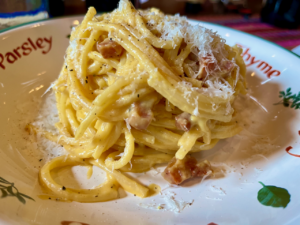
Pasta alla Carbonara
National Carbonara Day is celebrated annually on April 6. This date has been recognized since 2017 when it was established by Barilla Pasta and supported by the Italian Association of Confectionery and Pasta Industries (AIDEPI) and the International Pasta Organization (IPO) to honor the beloved Roman dish.
Pasta alla carbonara is a classic Italian dish from Rome. It is known for its rich, creamy sauce and wonderfully meaty and earthy bites of browned guanciale. Traditionally, it’s made with just a handful of components: pasta, eggs, Pecorino Romano cheese, guanciale, and black pepper.
Pasta alla carbonara’s origins are debated. Some tie it to Italian charcoal workers (carbonari) who made it over open fires. In contrast, others point to American GIs in post-WWII Italy, who mixed their bacon and egg rations with local pasta. Whatever the story, it’s been a Roman staple since at least the mid-20th century.
Let’s break down pasta alla carbonara’s essential ingredients:
- Pasta — dried, not fresh, is preferred. Spaghetti is the original choice, but Romans are fond of using Mezze Maniche (literally half sleeve), a shorter Rigatoni utilized in all four of Rome’s core pasta dishes (carbonara, Amatriciana, cacio e pepe, and alla gricia)
- Eggs — the very best eggs you can find.
- Cheese — Pecorino Romano cheese is preferred, as its salinity and unique tart flavors complement the rich egg cream sauce. Parmesan can be used, but it will result in a softer and sweeter dish.
- Pork — guanciale (cured pork cheek) is the perfect pork product for carbonara as it is meaty, slightly earthy (pleasingly funky), and properly fatty. Pancetta may be substituted if guanciale cannot be found, but the pasta will suffer. Smoked bacon should not be used as this will radically alter this classic dish.
- Black pepper — freshly cracked with a grind that is not too fine.
Just as important as what is in this classic Roman dish is what is NOT in pasta alla carbonara. Any self-respecting pasta lover should reject this dish if made with cream, garlic, onions, peas, or anything other than the five essentials. Among the assaults on the classic, cream is far and away the most common blunder. Uninstructed cooks use the cream as they don’t understand that the careful marriage of egg, cheese, guanciale fat, and pasta cooking water creates the dish’s creamy element.
Wine Pairings
Pairing wine with pasta alla carbonara is a satisfying challenge because of its rich, fatty guanciale, sharp Pecorino Romano, and bold black pepper. The ideal choices balance the dish’s intensity without overwhelming it, while daring options can push boundaries for an unexpected twist.
Can’t miss pairing include:
Frascati Superiore DOCG — Medium-bodied with ripe and crisp orchard fruits, blanched almonds, and just enough citrus flavors. It’s local from the Lazio region, unpretentious, and often a great value for money.
Chianti Classico works best when young and lightly oaked. The earthy and herbal tones sing with the guanciale and Pecorino Romano, while the natural acidity is the perfect foil for the rich sauce.
Classic Method sparkling wine, dry (brut level and drier), is a great accompaniment, especially Rosé versions with some red berry fruit. Lambrusco di Sorbara, Rosé Franciacorta, and Trentodoc are excellent choices.
Slightly unconventional but delicious wine choices include Soave, Barbera d’Asti, Lacrima di Morro, and Romagna Albana DOCG.
Avoid rich, heavily tannic, and oaky wines (like big Chardonnays or Cabernet Sauvignons) as they will trample the dish.
The Recipe
This dish can be executed in your home kitchen, and with practice, you will replicate the great dishes found in the best trattorias of Rome. This recipe serves four as a pasta course.
Ingredients:
320 g dried pasta (spaghetti or mezze rigatoni)
300 g guanciale cut into cubes or strips
5 egg yolks
50 g grated Pecorino Romano DOP
cracked black pepper
Salt for the pasta cooking water
The dish is made or broken in the execution. Bring a pot of water to a boil, and then add a tablespoon of salt. Add the pasta and cook according to the package instructions while aiming for al dente pasta. Guanciale is sautéed until crispy, releasing its fat, which becomes the base of the sauce. While the pasta is cooking, whisk the egg yolks with finely grated Pecorino Romano and a generous portion of cracked black pepper in a glass or stainless steel bowl. Warm the egg and cheese mixture over the pasta pot, allowing the steam to gently par-cook the sauce base. Be careful not to overheat the eggs, or they will scramble. You want a silky, creamy sauce — not scrambled eggs.
When the pasta is nearly cooked, add a few ounces of cooking water to the egg mixture, whisking vigorously. Once the pasta is cooked al dente, it’s strained and added to the egg-cheese mixture off the heat. The residual heat from the pasta and pan gently cooks the eggs, creating a silky, emulsified sauce that clings to every strand. If it is not fully emulsifying, place the bowl over the pasta water pot for a bit of gentle heat. Add the crispy guanciale and continue to heat through for a minute. It’s a balance of salty, fatty, and peppery notes when done right. Serve immediately in warmed bowls with the perfect glass of wine.
